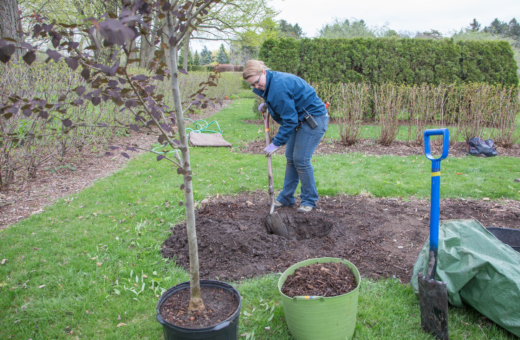July 18, 2023
One of the plants with the most showy blooms in the Arboretum’s new Grand Garden looks like something from a tropical island. It’s a hibiscus, with big white flowers several inches across that can be found on the east side of The Grand Garden, when in bloom.
Luna™ white rose mallow is a cultivated selection of Hibiscus moscheutos, a perennial that is native to eastern North America and is winter-hardy in the Chicago area.
Chicago-area gardeners may be surprised to learn that there is such a thing as hardy hibiscus. Most of the 200 hibiscus species grow in Asia and are far too tender to survive here.
Common rose mallow (Hibiscus moschuetos) and swamp rose mallow (Hibiscus palustris) are both native to wetlands and moist areas of eastern North America. Hibiscus palustris is actually considered native to the Chicago region.
Common rose mallow has flowers that can be 6 to 9 inches across, usually in shades of white, pink and red, with a distinct red center. Swamp rose mallow has pink to white flowers, although they’re a little smaller—just 4 to 6 inches across. They are large perennials that can grow 3 to 7 feet tall and 2 to 4 feet wide at maturity.
Because they evolved in wetlands and areas along rivers and creeks, both plants would be good choices for a low spot in a yard where water collects, or for a rain garden. They need regular watering, especially in dry periods, and mulch over their roots.
According to the Plant Clinic, these plants are often slow to sprout and start growing in spring, but once they do, they grow fast to make up for it. Pinching them back in late spring and early summer will help them stay more bushy.
Hardy hibiscus plants will flower best in full sun, although they can tolerate a little light shade. They need good air circulation to avoid disease, so give them plenty of space.
Each of the flowers lives only for a day or two, like a daylily, but the plants will keep opening new blooms over a long period, sometimes from July to September.
A number of cultivated varieties, or cultivars, have been selected or hybridized from Hibiscus moschuetos. At the Arboretum, several of these cultivars can be seen planted in the evaluation beds near Godshalk Meadow on the West Side.
Swamp rose mallow, the Chicago-area native, can be seen blooming in mid- to late summer among other native plants by the Arboretum’s Meadow Lake.
Both kinds of hardy hibiscus attract bees, including the specialist pollinator rose mallow bee, as well as offering nectar to hummingbirds and butterflies. Caterpillars of at least 28 species of butterflies and moths use them as host plants.



